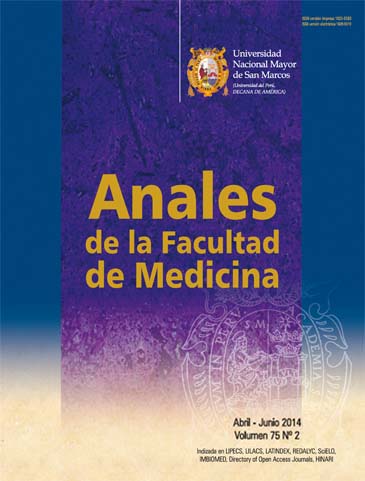Identification of Arcobacter in children and adult feces with/without diarrhea, and in animal reservoirs
DOI:
https://doi.org/10.15381/anales.v75i2.8389Keywords:
Arcobacter, fecal samples, children and adults, animal reservoirsAbstract
Introduction: Microorganisms of the genre Arcobacter considered emerging zoonotic pathogens are morphologically similar to Campylobacter. Reports of Arcobacteras as etiologic agent of diarrhea in humans in Latin America are scarce. In Peru its isolation in feces of humans or animals has not been reported. Objectives: To determine the prevalence of Arcobacter in feces of children and adults with/without diarrhea and in animals: birds, cattle, pigs, fish and seafood. Design: Cross-sectional study. Setting: Institute of Tropical Medicine Daniel A. Carrion, Universidad Nacional Mayor de San Marcos; National Institute of Child Health; Maternal and Child San Bartolome Institute; and Arzobispo Loayza Hospital. Biologic material: Bacterial isolates from stool samples of humans and animals. Interventions: Active search of Arcobacter sp. in human and animal feces, from July to October 2011. Main outcome measures: Prevalence of Arcobacter in feces. Results: Arcobacter sp. was found in samples from children with diarrhea (2/100), but not in those without diarrhea (0/97). In samples of adults with diarrhea (52) and without diarrhea (180), only one sample was isolated from a subject without diarrhea. Among animals, species with higher prevalence of Arcobacter sp were cattle (25%) and swine (29.2%). Among marine species, the two seafood species studied showed high prevalence: choro 24% (12/50) and prawns 22% (11/50). Conclusions: Arcobacter is a zoonotic germ potentially pathogenic to humans, particularly in children. Animal species used for human consumption should be studied systematically. It is important to perform studies in relation to ecological aspects, their behavior against antimicrobials and its transmissibility to humans.Downloads
Published
2014-06-16
Issue
Section
Original Breve
License
Copyright (c) 2014 Rito Zerpa Larrauri, Jorge O. Alarcón Villaverde, Percy E. Lezama Vigo, Lilian Patiño Gabriel, Alberto Reyes Dioses, Augusto M. Valencia Ramírez, Jorge Velásquez, Carlos R. Sevilla Andrade, Miriam J. Alarcón León

This work is licensed under a Creative Commons Attribution-NonCommercial-ShareAlike 4.0 International License.
Those authors who have publications with this magazine accept the following terms:
- Authors will retain their copyrights and guarantee the journal the right of first publication of their work, which will be simultaneously subject to Creative Commons Attribution License that allows third parties to share the work as long as its author and its first publication this magazine are indicated.
- Authors may adopt other non-exclusive licensing agreements for the distribution of the version of the published work (eg, deposit it in an institutional electronic file or publish it in a monographic volume) provided that the initial publication in this magazine is indicated.
- Authors are allowed and recommended to disseminate their work over the Internet (eg: in institutional telematic archives or on their website) before and during the submission process, which It can produce interesting exchanges and increase quotes from the published work. (See El efecto del acceso abierto ).
How to Cite
1.
Zerpa Larrauri R, Alarcón Villaverde JO, Lezama Vigo PE, Patiño Gabriel L, Reyes Dioses A, Valencia Ramírez AM, et al. Identification of Arcobacter in children and adult feces with/without diarrhea, and in animal reservoirs. An Fac med [Internet]. 2014 Jun. 16 [cited 2025 Jun. 2];75(2):185-7. Available from: https://revistasinvestigacion.unmsm.edu.pe/index.php/anales/article/view/8389



